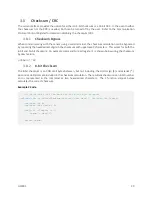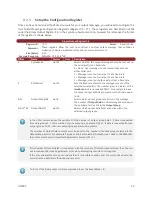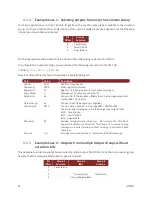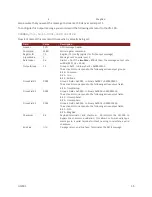
UM001
21
velocity, as well as the time varying gyro, accelerometer, and barometric pressure sensor biases. The
output of the INS Kalman filter is passed to the NavState, allowing for the attitude, position, and velocity
to be made available at the higher fixed rate of the NavState.
3.3.2
Vector Processing Engine
The Vector Processing Engine (VPE) is a collection of sophisticated algorithms which provide real-time
monitoring and simultaneous estimation of the attitude as well as the uncertainty of the input
measurements used by the attitude estimation algorithm. By estimating its own input measurement
uncertainty the VPE is capable of providing significantly improved performance when compared to
traditional statically tuned Kalman Filters. The estimated measurement uncertainty is used to in real-time
adaptively tune the onboard Kalman filters. This adaptive tuning eliminates the need in most cases for
the user to perform any custom filter tuning for different applications.
3.3.3
AHRS Kalman Filter
The AHRS Kalman filter consists of an EKF which nominally runs at the NavFilter Rate (default 200 Hz). The
AHRS Kalman filter simultaneously estimates the full quaternion based attitude as well as the time varying
gyro bias. The quaternion based attitude estimation eliminates any potential gimbal lock issues incurred
at high pitch angles, which can be problematic for Euler-angle based AHRS algorithms. The real-time
estimation of the gyro bias allows for the removal of small perturbations in the gyro bias which occur over
time due to random walk.
3.3.4
Hard/Soft Iron Estimator
The NavFilter subsystem also includes a separate EKF which provides real-time estimation of the local
magnetic hard and soft iron distortions. Hard and soft iron distortions are local magnetic field distortions
created by nearby ferrous material which moves with the sensor (attached to the same vehicle or rigid-
body as the sensor). These ferrous materials distort the direction and magnitude of the local measured
magnetic field, thus negatively impacting the ability of an AHRS to reliably and accurately estimate
heading based on the magnetometer measurements. To remove the unwanted effect of these materials,
a hard & soft iron calibration needs to be performed which requires rotating the sensor around in multiple
circles while collecting magnetic data for off-line calculation of the magnetic hard & soft iron calibration
coefficients. This calibration can be very time consuming, and might not be possible for some applications.
The onboard hard/soft iron estimator runs in the background without requiring any user intervention. For
many applications this simplifies the process for the end user, and allows for operation in environments
where the hard/soft iron may change slowly over time. While the onboard hard/soft iron estimator runs
in the background by default, it can be turned off by the user if desired in the Magnetic Calibration Control
Register.
3.3.5
World Magnetic Model
The world magnetic model (WMM) is a large spatial-scale representation of the Earth’s magnetic field.
The internal model used on the VN-100 is consistent with the current WMM2016 model which consist of
a spherical-harmonic expansion of the magnetic potential of the geomagnetic field generated in the
Earth’s core. By default the world magnetic model on the VN-100 is turned off, allowing the user to
directly set the reference magnetic field strength. Alternatively the world magnetic model can be
manually used to calculate the magnetic field strength for a given latitude, longitude, altitude, and date
which is then subsequently used as the fixed magnetic field reference strength. Control of the world
magnetic model is performed using the Reference Vector Configuration Register.






























